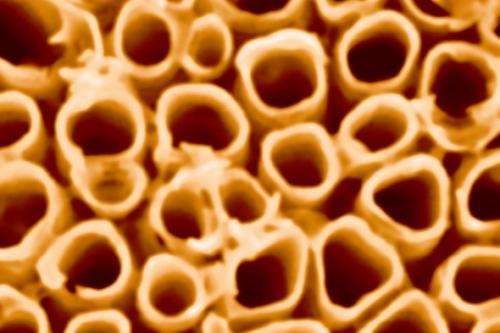Titania nanotubes go commercial: Potential use in fuel cells, solar panels

(Phys.org)—Seven years ago, physics professor Latika Mennon's first graduate student said he wanted to "change the world." She knew of her expertise in making nanoporous aluminum oxide and believed an analogous system with titanium dioxide, or titania, could be useful in the development of fuel cells and solar panels.
"Aluminum is more like an insulator," Menon explained. "For solar cells you need semiconductors. Titania is a semiconductor."
Using simple electrochemical methods, Menon's team developed a material made of neatly aligned, hollow, titania nanotubes. "It's an array of tubes," she said. "Just like lots of cylinders, or test tubes, arranged in parallel."
Menon explained that applying a voltage to a solution of chlorine-containing salts causes a piece of submerged titanium foil to oxidize on the surface. Under certain conditions, the titania will morph into the highly aligned structure she has described. "Since it's a self-assembly process, we don't have to worry about it, " Menon said.
The method is straightforward, cost effective and, perhaps most importantly, environmentally friendly. As such, Menon's work dovetails with Northeastern's focus on conducting use-inspired research that solves global challenges in health, security and sustainability.
Menon and her research team originally designed the material to be used in alternative energy applications, but she has found that it could be used in a host of other applications.
Backed by a $50,000 grant from the Innovation Corps program of the National Science Foundation, she is currently working to bring the technology into a commercial setting.
Menon's research team comprises Monidipa Ghosh, a research assistant, and entrepreneurial mentor Prashanth Makaram, cofounder of the biotech startup Alpha Szenszor, Inc., and a past member of professor Ahmed Busnaina's lab in Northeastern's Center for High Rate Nanomanufacturing.
Menon suggested that the technology's tubular platform could be used as a filter, noting that its uniform morphology makes it ideal for this particular application.
According to Menon, the titania nanotubes' biocompatible material makes it appealing for use in agricultural or cosmetics applications or as an alternative hydrogen generation catalyst for fuel cells, which currently use expensive platinum wires.
She also said that the nanotubes can be easily removed from the foil surface as thin, cohesive sheets. This property could make the technology useful for a variety of applications, including portable, flexible photovoltaics and solar cells.
Moreover, the color of these thin sheets is determined by the diameter of the nanotube. Since the dimensions can be controlled through tailored experimental conditions, Menon's team could conceivably design photovoltaic "paints" for the building and automotive industries.
Provided by Northeastern University



















